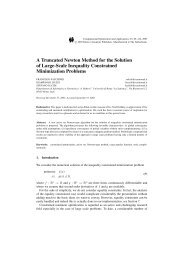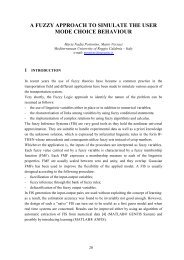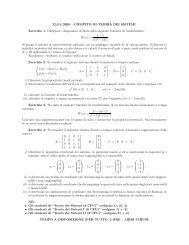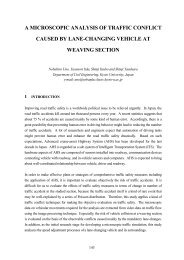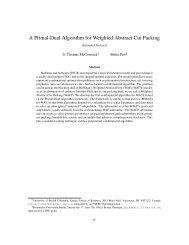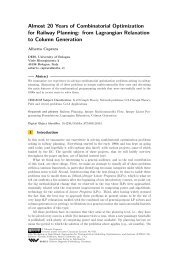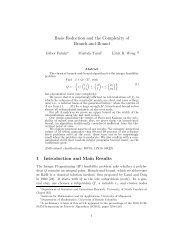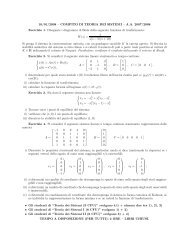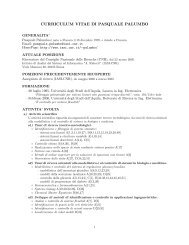effects of traffic analysis zones design on transportation ... - Iasi.cnr.it
effects of traffic analysis zones design on transportation ... - Iasi.cnr.it
effects of traffic analysis zones design on transportation ... - Iasi.cnr.it
Create successful ePaper yourself
Turn your PDF publications into a flip-book with our unique Google optimized e-Paper software.
It’s evident, then, as the number, the shape and not last, the homogene<strong>it</strong>y <str<strong>on</strong>g>of</str<strong>on</strong>g> socioec<strong>on</strong>omic<br />
characteristics (SE) ( expressi<strong>on</strong> <str<strong>on</strong>g>of</str<strong>on</strong>g> capac<strong>it</strong>y to generate and to attract trips), produce <str<strong>on</strong>g>effects</str<strong>on</strong>g><br />
<strong>on</strong> the outcomes <str<strong>on</strong>g>of</str<strong>on</strong>g> analyses <str<strong>on</strong>g>of</str<strong>on</strong>g> the system.<br />
In this note, <strong>it</strong> has been carried out a quant<strong>it</strong>ative evalutati<strong>on</strong> about <str<strong>on</strong>g>effects</str<strong>on</strong>g> <str<strong>on</strong>g>of</str<strong>on</strong>g> different levels<br />
<str<strong>on</strong>g>of</str<strong>on</strong>g> aggregati<strong>on</strong> <str<strong>on</strong>g>of</str<strong>on</strong>g> socioec<strong>on</strong>omic and demographic data into TAZs <strong>on</strong> outcomes resulting<br />
from the simulati<strong>on</strong> <str<strong>on</strong>g>of</str<strong>on</strong>g> a transportati<strong>on</strong> system, by proposing a methodology for the <str<strong>on</strong>g>design</str<strong>on</strong>g> <str<strong>on</strong>g>of</str<strong>on</strong>g><br />
z<strong>on</strong>e number and for the aggregati<strong>on</strong> <str<strong>on</strong>g>of</str<strong>on</strong>g> basic spatial un<strong>it</strong>s into homogeneous <str<strong>on</strong>g>z<strong>on</strong>es</str<strong>on</strong>g>.<br />
In Secti<strong>on</strong> 2 is described the state <str<strong>on</strong>g>of</str<strong>on</strong>g> the art about both z<strong>on</strong>ing methodologies and the<br />
influence <str<strong>on</strong>g>of</str<strong>on</strong>g> z<strong>on</strong>ing utilized <strong>on</strong> model’s results. In Secti<strong>on</strong> 3 is described the methodology<br />
adopted to solve TAZ <str<strong>on</strong>g>design</str<strong>on</strong>g> problem; <strong>it</strong> is also reported an applicati<strong>on</strong> <str<strong>on</strong>g>of</str<strong>on</strong>g> the methodology<br />
applied to a real case w<strong>it</strong>h the <str<strong>on</strong>g>analysis</str<strong>on</strong>g> <str<strong>on</strong>g>of</str<strong>on</strong>g> the obtained numerical result; in secti<strong>on</strong> 4 are<br />
reported the c<strong>on</strong>clusive c<strong>on</strong>siderati<strong>on</strong>s useful for following <str<strong>on</strong>g>analysis</str<strong>on</strong>g> and prospectives <str<strong>on</strong>g>of</str<strong>on</strong>g><br />
research <strong>on</strong> this subject.<br />
2 THE STATE OF THE ART ABOUT TERRITORY MODELLING<br />
The Z<strong>on</strong>ing <str<strong>on</strong>g>of</str<strong>on</strong>g> a study area c<strong>on</strong>sists <str<strong>on</strong>g>of</str<strong>on</strong>g> two subsequent phases:<br />
• Defin<strong>it</strong>i<strong>on</strong> <str<strong>on</strong>g>of</str<strong>on</strong>g> spatial aggregati<strong>on</strong> level <str<strong>on</strong>g>of</str<strong>on</strong>g> socioec<strong>on</strong>omic characteristics to achieve<br />
(determinati<strong>on</strong> <str<strong>on</strong>g>of</str<strong>on</strong>g> number <str<strong>on</strong>g>of</str<strong>on</strong>g> <str<strong>on</strong>g>z<strong>on</strong>es</str<strong>on</strong>g>);<br />
• determining shape and dimensi<strong>on</strong> <str<strong>on</strong>g>of</str<strong>on</strong>g> the <str<strong>on</strong>g>z<strong>on</strong>es</str<strong>on</strong>g> respecting the spatial aggregati<strong>on</strong> level<br />
determinated.<br />
To determine the number <str<strong>on</strong>g>of</str<strong>on</strong>g> <str<strong>on</strong>g>z<strong>on</strong>es</str<strong>on</strong>g>, Oppenheim (1995) asserts that no formal methods for<br />
defining the <str<strong>on</strong>g>z<strong>on</strong>es</str<strong>on</strong>g>’ system exist. Characteristics <str<strong>on</strong>g>of</str<strong>on</strong>g> these <str<strong>on</strong>g>z<strong>on</strong>es</str<strong>on</strong>g> must be decided <strong>on</strong> empirical<br />
bases in every specific s<strong>it</strong>uati<strong>on</strong>.<br />
In general the number <str<strong>on</strong>g>of</str<strong>on</strong>g> the <str<strong>on</strong>g>z<strong>on</strong>es</str<strong>on</strong>g> inside the study area is closely c<strong>on</strong>nected to the analisys’<br />
level that we want to achieve.<br />
In short-term operati<strong>on</strong>s management programs, the number <str<strong>on</strong>g>of</str<strong>on</strong>g> <str<strong>on</strong>g>z<strong>on</strong>es</str<strong>on</strong>g> to identify will be high.<br />
This will require the defin<strong>it</strong>i<strong>on</strong> <str<strong>on</strong>g>of</str<strong>on</strong>g> a transportati<strong>on</strong> network more detailed. In <str<strong>on</strong>g>analysis</str<strong>on</strong>g> <str<strong>on</strong>g>of</str<strong>on</strong>g><br />
strategic problems a smaller number <str<strong>on</strong>g>of</str<strong>on</strong>g> <str<strong>on</strong>g>z<strong>on</strong>es</str<strong>on</strong>g>, coherently w<strong>it</strong>h the supply model, is adopted<br />
(E. Cascetta, 1998; J. De D. Ortuzar, L.G. Willumsen, 1994).<br />
Gehlke e Biehl already in 1934 had noted the tendency for correlati<strong>on</strong> coefficients to increase<br />
w<strong>it</strong>h the level <str<strong>on</strong>g>of</str<strong>on</strong>g> aggregati<strong>on</strong> <str<strong>on</strong>g>of</str<strong>on</strong>g> census tracts. Openshaw e Taylor (1979,1981), Openshaw<br />
(1984), Fotheringham e W<strong>on</strong>g (1991) have studied errors that can affect <str<strong>on</strong>g>analysis</str<strong>on</strong>g> based <strong>on</strong><br />
aggregati<strong>on</strong>s <str<strong>on</strong>g>of</str<strong>on</strong>g> spatial data.<br />
Openshaw (1977), in particular, presented a hierarchical heuristic procedure for Automatic<br />
Z<strong>on</strong>ing Problem (AZP) by optimizing an objective functi<strong>on</strong> that was used to measure part<strong>it</strong>i<strong>on</strong><br />
performance in terms <str<strong>on</strong>g>of</str<strong>on</strong>g> a predefined target value.<br />
C. Ding (1998) analyzed impacts <str<strong>on</strong>g>of</str<strong>on</strong>g> socioec<strong>on</strong>omic data aggregati<strong>on</strong> into <str<strong>on</strong>g>traffic</str<strong>on</strong>g> <str<strong>on</strong>g>z<strong>on</strong>es</str<strong>on</strong>g>, at a<br />
nati<strong>on</strong>al scale (South Korea), w<strong>it</strong>h grav<strong>it</strong>ati<strong>on</strong>al demand models. He highlighted as the<br />
number <str<strong>on</strong>g>of</str<strong>on</strong>g> unsimulated intra-z<strong>on</strong>al trips is deeply affected from the number <str<strong>on</strong>g>of</str<strong>on</strong>g> <str<strong>on</strong>g>z<strong>on</strong>es</str<strong>on</strong>g><br />
especially when <strong>it</strong> is small. Ding deduced that existes a number <str<strong>on</strong>g>of</str<strong>on</strong>g> <str<strong>on</strong>g>z<strong>on</strong>es</str<strong>on</strong>g> that isn’t useful to



